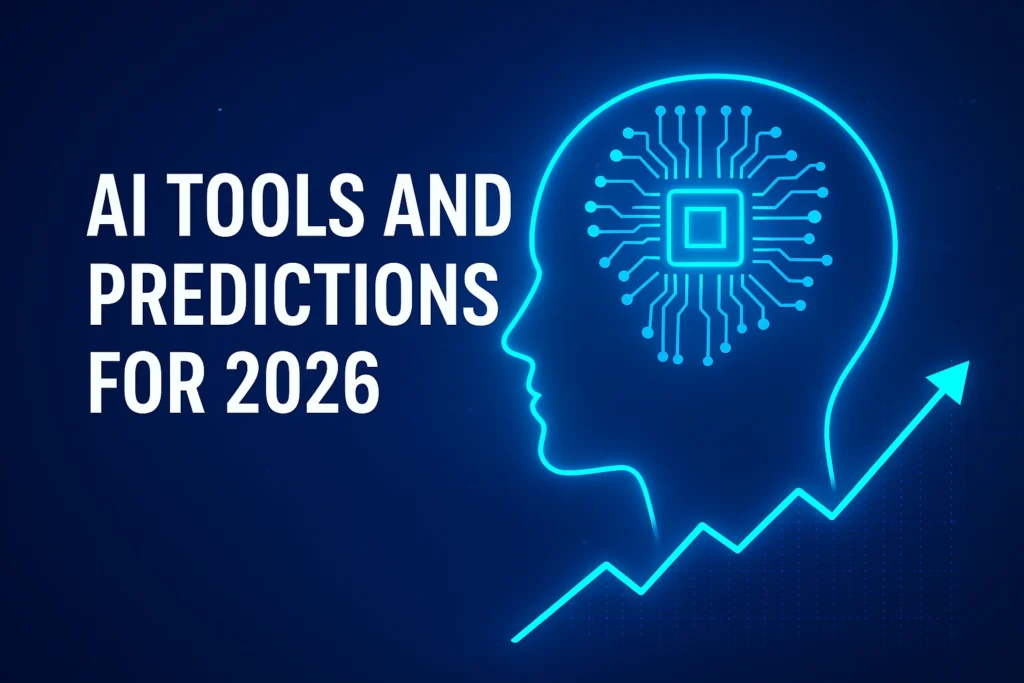Artificial intelligence (AI) has transformed from a niche technology into one of the most defining forces of the decade. As we step into 2026, AI tools are no longer experimental add-ons they are integral to business operations, creative industries, personal productivity, and even governance. From generative AI that creates content to predictive analytics that drives smarter decisions, the landscape of AI is rapidly evolving.
This article explores the top AI tools of 2026 and highlights the predictions for how AI will impact society, industries, and everyday life. Whether you’re a business leader, student, or curious observer, understanding these changes is essential for navigating the AI-powered future.
The State of AI in 2026
AI adoption has accelerated dramatically over the past three years. Reports estimate that by 2026, over 75% of global companies are using AI in some form. This includes customer support automation, data analysis, generative design, and cybersecurity defense.
Key trends shaping AI in 2026 include:
- Generative AI everywhere: Text, video, and image generation are standard business tools.
- AI copilots at work: From coding assistants to financial planning bots, most knowledge workers use an AI “copilot” daily.
- Regulation catching up: Governments are implementing clearer AI laws, focusing on transparency, copyright, and ethical use.
- AI hardware boom: Specialized chips and on-device AI (like in smartphones, earbuds, and home devices) reduce reliance on cloud-only systems.
Top AI Tools in 2026
1. Generative AI Platforms
Generative AI has matured into multi-modal platforms that handle text, images, audio, and video seamlessly. Tools like OpenAI GPT-6, Anthropic’s Claude Ultra, and Google Gemini 3 dominate the enterprise market, offering real-time translation, legal drafting, business planning, and marketing content creation.
Use Case Example: Marketing teams now generate campaign visuals, videos, and slogans in under an hour, cutting creative costs by over 60%.
2. AI-Powered Productivity Suites
Microsoft Copilot, Google Workspace AI, and independent startups provide intelligent assistants embedded directly into work tools. By 2026, employees can delegate scheduling, report generation, and data analysis to AI, making knowledge work faster and less repetitive.
Impact: A typical analyst in 2026 saves 10-15 hours per week by using AI automation inside spreadsheets, dashboards, and presentations.
3. AI in Healthcare
Healthcare-focused AI tools like DeepMind MedAssist, IBM Watson Health 2.0, and specialized startups now support diagnosis, drug discovery, and patient monitoring. AI helps detect diseases earlier and tailor personalized treatment plans.
Prediction: By 2026, AI-driven diagnostics reduce misdiagnosis rates by nearly 20%, especially in oncology and rare diseases.
4. Cybersecurity AI Tools
With cyber threats becoming more AI-driven, defense tools have adapted. Platforms such as CrowdStrike Falcon AI and Darktrace Evolution now provide real-time adaptive threat detection. These tools use predictive analytics to detect attacks before they occur.
Example: In 2026, companies deploy AI models that identify deepfake phishing attempts within seconds, preventing millions in potential losses.
READ MORE: TOP CAREERS TO STUDY FOR IN 2026
5. AI for Finance and Budgeting
AI-driven finance apps like Mint AI 2026, YNAB Evolution, and banking copilots provide hyper-personalized budgeting, savings, and investment strategies. Instead of generic advice, these apps adapt to individual goals and market conditions.
Prediction: AI tools in finance will manage 30% of personal investment portfolios worldwide by 2026.
READ MORE: TOP BUDGETING APPS IN 2026
6. Education and Exam Prep AI
From personalized AI tutors to exam simulation bots, AI has redefined education. GRE, GMAT, and SAT prep in 2026 often involves AI tutors that adapt in real-time to a student’s weaknesses.
Impact: Studies show students using AI-driven study assistants improve scores by an average of 15% compared to traditional prep methods.
READ MORE: GRE TEST DATES IN 2026
7. AI in Creative Industries
Designers, musicians, and filmmakers now collaborate with AI to speed up ideation and production. AI tools handle everything from soundtrack generation to 3D animation. However, regulation requires human oversight to avoid copyright conflicts.
Example: An independent filmmaker in 2026 can produce a full feature-length film with AI assistance at one-tenth the cost compared to 2020.
8. AI in Translation and Communication
On-device AI translators integrated into earbuds like Apple AirPods Pro 2026 enable near-perfect real-time translation across 60+ languages. This has massive implications for tourism, international trade, and global collaboration.
READ MORE: UPCOMING GADGETS TO EXPECT IN 2026
Predictions for AI in 2026 and Beyond
1. AI Regulation Will Mature
Governments worldwide are introducing AI compliance frameworks, requiring companies to disclose when AI-generated content is used and mandating audits for bias and fairness. The EU and U.S. lead with strong data protection and model accountability laws.
2. AI and Job Transformation
Rather than outright replacing jobs, AI is transforming them. By 2026, AI handles routine and repetitive tasks, while humans focus on decision-making, creativity, and strategy. New job roles like AI ethicists, prompt engineers, and AI auditors are emerging.
3. AI in Daily Life
AI has become as common as smartphones. From smart home devices that predict your needs to personal health coaches embedded in wearables, AI blends seamlessly into everyday routines.
4. AI-Powered Governments and Smart Cities
Cities are deploying AI for traffic optimization, energy efficiency, and urban safety. Governments use AI for predictive policy analysis, though privacy concerns remain high.
Prediction: By 2026, at least 20 major cities worldwide will rely on AI systems for managing utilities and traffic flows.
The Risks Ahead
While AI presents opportunities, risks include:
- AI-Driven Disinformation: Deepfakes and fake news are harder to detect.
- Over-Reliance on Automation: Organizations may become too dependent on AI decisions.
- Ethical Concerns: Bias in training data continues to challenge fairness.
- Cybersecurity Threats: AI itself can be weaponized by malicious actors.
READ MORE: How to Protect Yourself from AI-Driven Phishing in 2026
Preparing for the AI Future
Individuals and businesses should:
- Adopt AI mindfully: balance automation with human oversight.
- Invest in AI literacy: understand how tools work, not just how to use them.
- Focus on ethics and compliance: stay aligned with emerging regulations.
- Experiment early: businesses that integrate AI strategically in 2026 will outpace competitors by 2030.
Conclusion
AI in 2026 is more than a technology it is a global shift in how we work, communicate, and make decisions. The rise of generative AI, intelligent copilots, and AI-driven governance highlights a world where artificial intelligence is deeply embedded in daily life. At the same time, challenges around ethics, fairness, and security remind us that AI’s evolution must be managed responsibly.
The companies, professionals, and governments that strike the right balance will define the future. For individuals, the best strategy is not to fear AI but to learn, adapt, and leverage it for growth.

